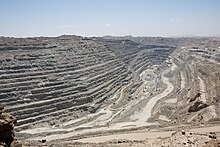Rössing Uranium Mine
 |
|
| Location | |
|---|---|
| Location | Namib Desert |
| Region | Erongo |
| Country |
|
| Coordinates | 22°29′03″S 015°02′56″E / 22.48417°S 15.04889°ECoordinates: 22°29′03″S 015°02′56″E / 22.48417°S 15.04889°E |
| Production | |
| Products | Uranium |
| History | |
| Opened | 1976 |
| Owner | |
| Company | Rio Tinto Group, Iran, Namibia |
| Website | Rossing.com |
The Rössing Uranium Mine in Namibia is the longest-running and one of the largest open pit uranium mines in the world and is located in the Namib Desert near the town of Arandis, which is 70 kilometres from the coastal town of Swakopmund. Discovered in 1928, the Rössing mine started operations in 1976 and, in 2005, produced 3,711 tonnes of uranium oxide, becoming the fifth-largest uranium mine with 8 per cent of global output. Namibia is the world's fourth-largest exporter of uranium.
In the apartheid era, the Rössing uranium mine was the focus for international criticism and protests by anti-apartheid and anti-nuclear groups, mainly in Europe. Reports that Rössing's uranium might be diverted to Iran, whose government owns 15% of the shares in the mine via its Iranian Foreign Investment Company, have been denied by the mine's management which maintains that the shareholding is entirely passive.
A catastrophic structural failure of a leach tank resulted in a major spill at Rossing on January 17, 2014.
Uranium was discovered in the Namib Desert in 1928 but explorations began only at the end of the 1950. Rössing is the largest of three mines exploiting Uranium in the Namib, the others are Langer Heinrich operated by Paladin, and Husab (under construction), under Chinese ownership. The open pit mine's production capacity is 4,500 tons.
Rössing is a low-grade ore body of huge extent. Producing 1,000 tonnes of uranium oxide requires processing of 3 million tonnes of ore, and in 2005 19.5 million tonnes of rock were mined and transported from the open pit to the processing plant. Of those, 12 million tonnes were uranium ore, which in turn required 226,276 tonnes of acid for processing into yellowcake, a powdered uranium concentrate which is the basis for nuclear reactor fuel.
...
Wikipedia

